|
FAQs about Mussid Coral Disease Diagnosing
FAQs on Mussid
Disease:
Mussid Disease 1, Mussid Health 2, Mussid Disease 3, Mussid Disease 4,
Mussid Disease 5,
FAQs on Mussid Disease by Category:
Environmental (Pollution/Poisoning, Lighting...),
Nutritional,
Social (Allelopathy),
Trauma,
Pathogenic (Infectious, Parasitic, Viral)
Predatory/Pest,
Treatments
Related Articles: Coral Pests and Disease; pests, predators,
diseases and conditions by Sara Mavinkurve, Mussid Corals,
FAQs on Stony Coral Disease: Stony Coral Disease 1, Stony Coral Disease 2, Stony Coral Disease 3, Stony Coral Disease 4, Stony Coral Disease 5, Stony Coral Disease 6, Stony Coral Disease 7, Stony Coral Disease 8, Stony Coral Disease 9, Stony Coral Disease 10, Stony Coral Disease 11, Stony Coral Disease
12, Stony Coral Disease 13,
Stony Coral Disease 14,
Stony Coral Disease 15, Stony Coral
Disease ,
FAQs on Stony Coral Disease by Category: Diagnosing:
Environmental (Pollution/Poisoning, Lighting...),
Nutritional, Social (Allelopathy),
Trauma,
Pathogenic (Infectious, Parasitic, Viral)
Predatory/Pest,
Treatments
FAQs on Stony Coral Disease by Family: Acroporid Disease, Acroporid Disease 2, Acroporid Disease 3, Acroporid Disease 4..., Caryophyllid Disease, Caryophyllid Disease 2..., Elegance Coral Disease/Pests, Dendrophylliid Disease, Faviid Disease, Faviid Disease 2, Fungiid Disease,
Mussid Health 2, Poritid Health, Trachyphylliid Disease, Trachyphyllia Disease 2,
FAQs on Stony Coral Disease by Type: Brown Jelly Disease, RTN,
|
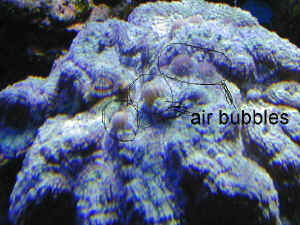
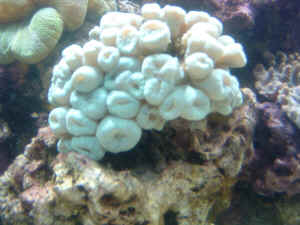
|
|
Brown discoloration on brain coral
12/21/15
<Why send four megs of uncropped pix? What are our requested limits?>
Hi Again! Looks like I need your thoughts here. I have had this red brain coral
for about a year and he has been thriving. Recently I have noticed some brown
discoloration. He still expands fully. Is this the start of brown jelly disease?
<Possibly>
The yellow leather above has been getting huge and is now partially shading him
a bit.
<Ahh! Much more likely an allelopathogenic effect from the Alcyoniid then....
see WWM Re; separate the two more, use chem. filtrants, improve ORP/RedOx....>
Or are my halides too intense for him?
<Doubtful>
Thanks for any input. My water parameters are excellent. I am pretty obsessive
with maintenance and testing. I would be shocked if it were a water quality
issue.
<Not likely>
Kinley
<Bob Fenner>
|
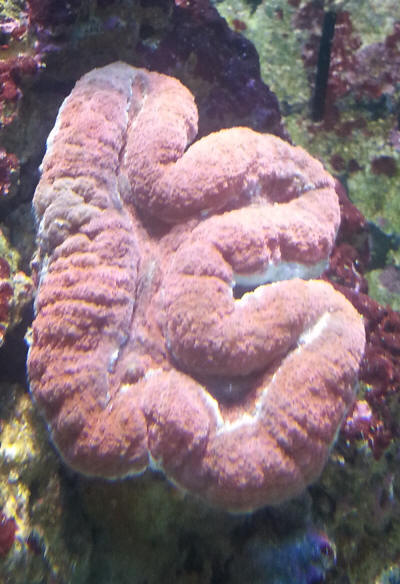 |
|
Re: Brown discoloration on brain coral
12/21/15
Thank you! I'm relieved. Sorry about the pic size.
<Ahh! This requirement, request is posted on where folks find to write us>
It was not my intent to overload. I'll figure that out for next time! Not tech
savvy :-(
<Appreciate your self-effacement. Cheers, BobF>
|
|
Dying Coral? A joke? No data of use or reading
6/27/10
I am not really sure exactly what type of coral this is.
<...? Looks like a "melting Mussid" of some sort...
perhaps a Lobophyllia sp.>
I have had it for about a year and it has always been beautiful.
The last week however it has really started to droop badly.
<!>
I have read that corals droop like this when they are
stressed,
<... to the point of dying>
but I don't know what is stressing it. It was located near a
spot where I had recently placed some new stuff
<...>
and I thought that may be the problem, so I moved it up higher in
the aquarium so it would get more light and airflow, but so far
it isn't helping.
<What? Is this a joke? Really? Read on WWM re the family,
allelopathy. Bob Fenner>
|
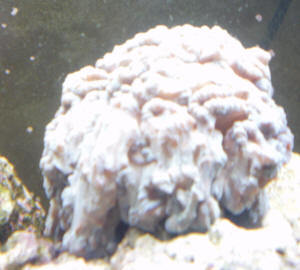 Melt down! Melt down! |
|
Re: Dying Coral? Mussid... 6/27/10
Maybe I am just stupid, but I really do not understand your
response. I have looked on your website and the only thing I find
that may help is that maybe I need to move to coral to where
there is less airflow, but as far as what is causing my problem I
am still at a loss.
<... what? Again... is this a joke? B>
Re: Dying Coral?
This is no joke and I am getting a little annoyed. I am looking
for help in keeping my coral healthy.
<Please see re the family... Mussidae.... on WWM. B>
|
|
Coral problem, lack of data, reading
1/23/10
Hi Crew,
Thanks to you all, I always can find an answer to any questions I
have.
This time I got a problem with my LPS. I had it I'm my tank
for about 8 months and it was doing good : reacting to target
feeding, normal day/night contractions, was growing slightly too
.
<Lobophyllias are typically tough, given basic conditions,
care>
I target feed my corals about 3 times a week, partial water
change 2 times a week, water parameters are OK.
<...?>
Last night it did not respond to feeding, and this morning I
noticed a hole where was its mouth. I'm sure it was not there
last night. What it could be?
<Indication of...?>
How can I solve the problem? Everything else is doing well. Even
I got Goniopora sp. growing from nowhere on my live rocks.
Thank you very much for all your help to hobbyists like me.
Best regards,
Igor
<Please read here:
http://wetwebmedia.com/mussiddisfaqs.htm
and the linked files above, to give you input, background into
the types of information we're looking for. Bob
Fenner>
|
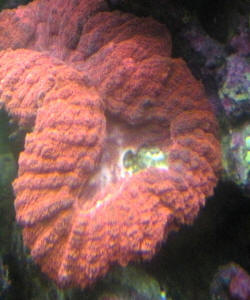 |
|
Re: coral problem, Lobo...
1/24/10
Hi Bob,
Thank you for the link. It is helpful. I am just so stupid to
find out how to insert my input there.
Best regards,
Igor
<Umm, get some help. Really. B>
|
Troubled over moon brain coral 03/24/08 Hi Crew, I have
a quick question. I am actually fairly new at having a reef system.
I have a 55 gal. tank and I purchased a piece of moon brain coral I
believe it to be about 7 months ago. <This is a Mussidae sp.,
not usually called "brain coral." They're usually
called "brain corals." Please see here:
http://www.asira.org/lobophylliasymphylliaothermussideans
http://www.wetwebmedia.com/mussidae.htm > I've attached a
photo. When I brought it as you can see it seem to be health.
However, as of about a couple of weeks ago I got to noticing how
bad it was looking started to turn red/brown color looking.
<Hmm, darkening in color is necessarily a sign of declining
health.> Just over two days ago after I did a water change and
system clean it has had a hole to develop in the middle of it.
<Are you sure this isn't the "mouth" of the polyp
gapping?> I have gave it live marine phytoplankton, <This is
good for your tank life in general, but doesn't directly feed
this coral (feeds it more indirectly).> moved it under the rock
to the shade more as well as feeding it frozen foods, about once a
week (as I have been doing since purchase). What I need to know if
I should be worried about possible other reef I have introduced
into my tank has caused to go down hill. <I'm not entirely
convinced it is going down hill. Can you take a picture of what it
looks like now?> The last thing I put in was some sun coral and
mushrooms and two anemones this was several months after I had
purchased this piece of brain coral? And what possible I could do
to nurse it back to health? And should I move to another tank? If
you could get back with me with a answer that would be awesome.
<Again, I could probably help you more if I were more sure of if
there is actually anything wrong (pic would/will help).> Thanks
for your help
Nikki
<De nada,
Sara M.> |
|
 Sara... you've got to move the
files... RMF Sara... you've got to move the
files... RMF
|
Blastomussa
wellsi Troubles 2/18/06 Hello. I (as the title says) am having some
troubles with a Blasto Wellsi I recently purchased. I bought it about a
week ago and placed it in the bottom of the tank in low flow and low
light. For the first few days, it opened fully and looked great. But
then on about the third day, it didn't open completely. Day by day,
it's been opening less and less. I wouldn't be worried so much
about it, but this is the exact say way my last Blasto Wellsi colony
died last fall. I was never able to figure out then why it died and
finally decided it was probably caused by something that happened
before I bought it. Now I'm not so sure. I have since lifted it up
on to a small piece of pvc in the corner to keep it away from the
hermit crabs (they have a knack for annoying new corals sometimes).
<In addition to hermits, do consider your fish, especially pygmy and
dwarf angels and blennies. You may have to observe very
carefully to notice them picking at the coral. Also, in my
experience, these corals are very sensitive to water quality especially
those parameters that can't be measured, like the noxious defensive
chemicals of other corals.> The lighting is two 96W PC 12 hours a
day on a 45 gallon tank. It's been set up for about a year now. As
for water conditions, they're fine (78 degrees; S.G. 1.025; 0
Ammonia, Nitrite, Nitrate, Phosphate; Calcium 430) as they have always
been, and no other corals (including many zoos and Shrooms, a few LPS
and SPS, and some rather large softies) are showing any signs of
trouble. <What about alkalinity? Without proper
alkalinity, calcium is unusable to corals. Also, Zoanthids,
mushrooms and softies are all good candidates to produce harmful
allelopathic chemicals that my be harming the Blastomussa.> Nothing
has been done since I received the coral that would change water
clarity (water changes, cover glass cleaning, new bulbs, carbon, etc.).
I think that's all the info I can offer. Thank you,
Kevin <You can try running some carbon to help reduce the defensive
chemicals from the other corals and please do measure alkalinity
regularly and correct if low. Hope this
helps. Best regards. AdamC.>
Lobophyllia tissue recession 3/31/05
Hello, I have a Lobophyllia spp. For 2 months and never has been very
healthy, firstly started with a small body reduction in the upper part
(it was inclined in the aquarium) so I moved it down. But 2 weeks ago
it started to have a severe body depletion, I have read different
articles about corals, bleaching etc and I would like to know if I
should move it down a bit more or any other tip. Thanks very
much. <"Tissue recession" is the most common term
for this. Bleaching refers to the loss of Zooxanthellae (symbiotic
algae) and color from otherwise normal healthy tissue. Lobophyllia is
quite adaptable to different lighting conditions, but in my experience
it is quite sensitive to water quality and the defensive chemicals
produced by other corals. I would suggest thoroughly testing your water
and making sure the following parameters are in the proper range: pH
8.0-8.4, Alkalinity 2.75-4.0 mEq (9-12 dKH), Salinity 1.025, Calcium
350-450, temp 79-82. If you have soft corals (especially leathers or
mushrooms), it would be a good idea to run small amounts of carbon and
change it weekly and perform 20% monthly water changes. Best Regards!
AdamC.>
| Candy Cane Coral 3/8/04 Hi Bob, <Anthony
Calfo in his stead> Thanks for the help with the candy cane
coral so far. I have searched the web and the FAQs
for... too long. I am meeting with a man tomorrow about
purchasing a candy cane coral. I noticed that the color
is usually a brown or a green. I am concerned when I met
with this guy that I will not know whether it is healthy or
not. Could you please give me some pointers as to color,
and basic appearance so that I get a healthy specimen. <it's
tough to summarize in the brevity of an e-mail. Obvious factors to
look for would be any recession of tissue, exposed corallum
("skeleton"), excessive mucus. But before you buy any
coral without knowing how to assess health, please, please, please
invest in a good book or two. John Tullock, Eric Borneman and, if I
may say so, my works on corals are easy to read, popular and
informative. For corals with pictures... I can recommend Eric
B's "Aquarium Corals" as your first choice. Please
make the responsible choice and do not buy any animal without
knowing how to care for it first. Caulastrea (candy cane coral) is
fairly hardy and easy to keep, but requires feeding weekly or more
often, and will not acclimate easily to very bright halide
light> Thank you very much, Todd Hawman I should have included a
picture of what was posted on the net by the seller. http://www.buysell.com/bestoffer/viewoffer.asp?id=26121043
this is the address to the picture he provides....not sure if it is
actually his. Please help!! <the
picture/coral is odd... appears to be healthy, but the polyps have
an inflated look. May simply be a photo soon after a feeding>
Also if this is a healthy coral... should I start acclimation (in
terms of lighting) very near the bottom on rock?? I have
a 90 gallon tank... 24" deep and have a 4 foot 32 watt
fluorescent light. Thank you very much. Todd Hawman
<keep this coral in the top 1/3 of your tank. Fluorescent lights
may be good quality but they are weak (unable to penetrate water at
depth). I do have an article here on WWM specifically on
"acclimating symbiotic reef invertebrates" to new lights.
Do seek it (use the Google search tool at the bottom of the
index/home page). Best of luck, Anthony> |
|

|
| Bubbles in my Brain!!! (air trapped in coral
tissue) 4/19/03 ok.. I attached a photo, but this morning is
the first time I've seen this occur on my Lobophyllia.. it
looks almost as if there are air bubbles inside the flesh of the
brain coral.. <there are several possible reasons for this not
entirely uncommon occurrence. In the safest/simplest
circumstance... some corals simply "eat" air bubbles (or
are fed it trapped in food). As strange as it might sounds... the
deliberate ingestion is done by some of the more heavily mucous
species for the purpose of capturing food and elements such as
proteins that are attracted to the air bubbles (Yes... indeed like
the organics "stuck" to air bubbles in protein skimmers).
In these cases though... the tiny air bubbles are easily purged.
When they are large and apparent as in your case here... it leads
me to believe one of two things... forced ingestion of an
inappropriate food (freeze dried foods for example... that have
much air trapped inside)... or stress. The former is
self-explanatory... and the coral is likely to expel it in time,
although you don't want to make that a habit! In the case of a
stress induced symptom here... there are a few things it could
be... and neither are good. The first is over stimulation
(over-driving/photoinhibition) of corals by light that is too much
or on too long (for this species if only in the tank). New bulbs,
cleaned lamps, improved water clarity (carbon used after an
absence), etc... all are things that improve or increase the
quality of light and cause the Zooxanthellae to work overtime to
the extent that they produce oxygen inside Cnidarian tissue that
cannot be processed fast enough. The other possibility is
supersaturation of the water with oxygen by a leak in the plumbing
(causing the aspiration of air to super-sat-levels)... OR... the
inappropriate addition of hot water to cool water (during a water
change or evap top off) to make "warm" water which drives
the O2 out of solution quickly (the reverse of super-saturation).
This can occur right within the corals tissue just like divers that
get the "bends" from nitrogen. Not good at any rate.>
it's been fine up until now and the only thing that is changed
is that I fed it chunks of krill last night before I went to
bed. <no worries unless the krill was freeze
dried or any food that floats that world indicate trapped air>
is this something I should worry about? or take caution of?
<perhaps... do consider the above possibilities and why it may
have occurred> another thing I was wondering was that I have a
large toadstool leather that stopped opening during the day...
I've noticed polyp extension at night about an hour after the
lights go off, but other than that it fully expands during the
day.. just that there's no polyp extension. <interesting...
generally not a big deal (they do not feed organismally with their
tiny polyps by much. However... in light of the Lobo's
symptoms... the polyps shutting down early does indicate a possible
lighting problem. Are you one of those kooks using 400 watt halides
on a 20 gallon aquarium <G>? Perhaps have your lights on too
long (over 8-10 hours on MH... or over 12-14 on fluorescents).
Perhaps changed to brand new bulbs recently? Hmmmm... many
possibilities here.> I'd really appreciate any information.
Jonathan <best regards, Anthony> |
|

|
|
Air Bubbles in Coral Tissues ("Bubbles in my Brain")
4/19/03 thanks for the response.. it makes sense on the light
stimulation... he had just been recently moved to a higher point in the
tank.. but has since been moved into another tank in which his air
bubble situation returned to normal.. <ahhh, yes... very plausible
and consistent with our theory. Great to hear that your brain is not so
gassy <G>. FWIW... corals that express such symptoms (air bubbles
from excess light as with sudden move to higher point) can in fact
acclimate to the new higher position in time... they just need to be
acclimated slower to prevent the air bubbles from forming. Use the
screen method (suggested in my articles here on WWM and beyond) to
adjust the coral to brighter light over a period of a couple weeks>
and I almost forgot to add.. I LOVE your coral propagation book.. the
wealth of information is priceless and I've been looking for a book
exactly like this for years. Jonathan <thanks kindly, my friend!
Best of luck to you in your endeavors. Anthony>
|
Problem with Lobophyllia Dear Bob, As always, thanks so much
for this great site. I have another question that I'm sure you can
answer. <I will try> Last Tuesday, I received my order of a
Lobophyllia hemprichii (red brain coral) and a Euphyllia glabrescens
(torch coral) from a dealer that is well known and, supposedly, very
well respected in the trade. When I removed the torch coral from its
bag, I could see nothing but the white skeleton and a few places where
the polyps were supposed to extend. After two days of waiting, as
instructed by the dealer, the polyps never came out and they just
became shriveled and died. That must have been RTN. <Maybe> As
for the brain, it has not died, but I am very concerned about it. When
I first received it, I placed it in the bottom of my 90-gallon tank and
even shaded it from the VHO lighting for some time. The coral opened
some during the day, but when it retracted, a large part of the
skeleton was exposed. In fact, the "spines" show when the
coral is contracted. <This happens with new specimens> According
to our research, the coral should be of such a size that no part of the
skeleton should ever show and that the whole coral should look more
robust. The coral we received looks so "thin". When it's
expanded, there are pinpoint places that are depressed; and the flesh
looks "corroded". The color is rust red now; it may have been
darker and lost some of it's color, but that is hard to determine.
At times, the coral would expand when the main aquarium pump was turned
off, while at other times it would expand when the pump was turned on.
The coral gives off this rust-colored cloud when the pumps are turned
off. This morning it looked better; however, when I turned off the main
pump it retracted and gave off its rust-colored matter. The dealer says
in their literature that this coral would "slough off" some
when first introduced, but it seems to be sloughing off its flesh and
deteriorating. The aquarium is a 90-gallon reef with all parameters at
or near perfect reef readings. We have a 30-gallon sump, Turboflotor
skimmer, Aqua UV sterilizer, and a water turnover rate of about 10
times per hour. Other inhabitants look great. There is not a heavy
bio-load as there is just a purple tang, a peppermint shrimp, some
mushrooms, a purple blade, some snails, and a few scarlet hermit crabs,
and three sand sifting starfish. All water is purified by Kold Steril.
I added vitamin C and some trace elements (Vital Gold) by Thiel, along
with Coral Vital by Marc Weiss. Any thoughts? Thanks for any help you
can give. Regards, Michael Rivera <Per the descriptions of both
newly arrived specimens, it does seem like they were either "in
the bag" too long, or suffered some other sort of shipping insult
(chilled, overheated... delayed in transit...). At any length, you can
just wait at this point and hope that they will regenerate. Nothing in
your description points to a difficulty in your system or handling...
Bob Fenner>
|
|

